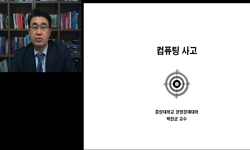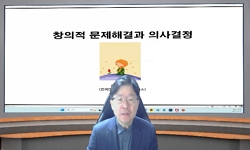본 연구의 목적은 19명의 중학교 2학년 수학 영재 학생들의 문제 만들기의 특징을 조사하는 것이다. 본 연구에서는 먼저, 선행 연구에서 제안된 분석 틀을 중심으로 영재 학생들의 문제 만들...
http://chineseinput.net/에서 pinyin(병음)방식으로 중국어를 변환할 수 있습니다.
변환된 중국어를 복사하여 사용하시면 됩니다.
- 中文 을 입력하시려면 zhongwen을 입력하시고 space를누르시면됩니다.
- 北京 을 입력하시려면 beijing을 입력하시고 space를 누르시면 됩니다.
부가정보
국문 초록 (Abstract)
본 연구의 목적은 19명의 중학교 2학년 수학 영재 학생들의 문제 만들기의 특징을 조사하는 것이다. 본 연구에서는 먼저, 선행 연구에서 제안된 분석 틀을 중심으로 영재 학생들의 문제 만들기에서 나타난 확장성과 정교성을 살펴보았다. 다음으로, 영재 학생들이 문제 만들기에서 변경한 조건들을 상세하게 분석하여 영재 학생들의 문제 만들기를 ‘수평적 문제 만들기’와 ‘수직적 문제 만들기’ 및 하위 범주로 분류하였다. 본 연구의 결과, 중학교 영재 학생들의 수학 문제 만들기는 확장성과 정교성의 측면에서 충분하지 않은 것으로 나타났다. 또한, 영재 학생들은 새로운 문제를 만들 때 원래 문제보다 복잡성이 감소하는 방향으로 문제를 만들며, 원래 문재에 제시된 조건들을 개별적으로는 고려하지만 종합적으로는 고려하지 않는 것으로 나타났다.
다국어 초록 (Multilingual Abstract)
The purpose of this study is to investigate the characteristics of problem making of 19 mathematically gifted students in junior high school. In this study, we examined the expansion and sophistication of the problems made by gifted students, focusing...
The purpose of this study is to investigate the characteristics of problem making of 19 mathematically gifted students in junior high school. In this study, we examined the expansion and sophistication of the problems made by gifted students, focusing on the analysis framework proposed in the previous research. Next, the problem making by gifted students were categorized into ‘horizontal problem making' and ‘vertical problem making.' As a result of this study, it was found that problem making by gifted students was not enough in terms of extension and sophistication. In addition, gifted students made problems in the direction of decreasing complexity than original problems when creating new problems, and considered the conditions presented in the original text separately but not comprehensively.
참고문헌 (Reference)
1 임문규, "초등 5학년 수학영재 학생이 만든 수학문제에 관한 조사⋅분석" 대한수학교육학회 15 (15): 701-721, 2013
2 임근광, "종이접기 프로그램에서 수학영재학생들의 문제 만들기 전략 분석" 한국영재학회 20 (20): 461-486, 2010
3 에르든예프, "유추를 통한 수학탐구" 도서출판 승산 2010
4 이대희, "영재학급 학생들이 What-If-Not 전략을 사용하여 만든 변형 루미큐브 게임 사례 분석" 한국초등수학교육학회 17 (17): 285-299, 2013
5 송상헌, "수학영재들이 NIM 게임 과제에서 만든 문제 만들기 사례 분석" 대한수학교육학회 17 (17): 51-66, 2007
6 교육부, "수학과 교육과정"
7 박미미, "수학 문제유추에 의한 관계적 구조의 지도" 서울대학교 2015
8 최왕균, "수 퍼즐 문제 만들기 과제에서 나타나는 초등수학 영재들의 수학적 사고특성 분석 : 문제설정과 일반화사고를 중심으로" 아주대학교 교육대학원 2011
9 Renzulli, J. S., "The Schoolwide Enrichment Model: A Comprehensive Plan for Educational Excellence" Creative Learning Press 1986
10 Brown, S. I., "The Art of Problem Posing" Lawerence Erlbaum Associates 1983
1 임문규, "초등 5학년 수학영재 학생이 만든 수학문제에 관한 조사⋅분석" 대한수학교육학회 15 (15): 701-721, 2013
2 임근광, "종이접기 프로그램에서 수학영재학생들의 문제 만들기 전략 분석" 한국영재학회 20 (20): 461-486, 2010
3 에르든예프, "유추를 통한 수학탐구" 도서출판 승산 2010
4 이대희, "영재학급 학생들이 What-If-Not 전략을 사용하여 만든 변형 루미큐브 게임 사례 분석" 한국초등수학교육학회 17 (17): 285-299, 2013
5 송상헌, "수학영재들이 NIM 게임 과제에서 만든 문제 만들기 사례 분석" 대한수학교육학회 17 (17): 51-66, 2007
6 교육부, "수학과 교육과정"
7 박미미, "수학 문제유추에 의한 관계적 구조의 지도" 서울대학교 2015
8 최왕균, "수 퍼즐 문제 만들기 과제에서 나타나는 초등수학 영재들의 수학적 사고특성 분석 : 문제설정과 일반화사고를 중심으로" 아주대학교 교육대학원 2011
9 Renzulli, J. S., "The Schoolwide Enrichment Model: A Comprehensive Plan for Educational Excellence" Creative Learning Press 1986
10 Brown, S. I., "The Art of Problem Posing" Lawerence Erlbaum Associates 1983
11 백대현, "Problem Posing by Mathematically Gifted Middle School Students: A Case Study" 대한수학교육학회 12 (12): 259-271, 2010
12 Alvarez, S. A., "Note on an n-dimensional Pythagorean theorem"
13 Polya, G., "How to Solve it" Doubleday & Company, Inc 1957
14 Gagne, F., "Handbook of Gifted Education" Allyn and Bacon 65-80, 1991
15 Sheffield, L. J., "Extending the Challenge in Mathematics : Developing Mathematical Promise in K-8 Students" Texas Association for the Gifted and Talented 2003
16 Sheffield, L. J., "Developing Mathematically Promising Students" National Council of Teachers of Mathematics 1999
동일학술지(권/호) 다른 논문
-
자연상수 e에 대한 이해를 기반으로 지수함수 y=2^x의 x=0에서의 순간변화율 구성에 관한 연구
- 대한수학교육학회
- 이동근
- 2017
- KCI등재
-
‘규칙과 대응’에 대한 2007 개정 및 2009 개정 초등학교 수학 교과서 분석
- 대한수학교육학회
- 방정숙
- 2017
- KCI등재
-
세 자리 수의 범위에서 학습한 덧셈과 뺄셈 원리의 일반화 가능성
- 대한수학교육학회
- 장혜원
- 2017
- KCI등재
-
개방형 문제와 선택형 문제 해결에 나타난 학생의 추론 비교
- 대한수학교육학회
- 이명화
- 2017
- KCI등재
분석정보
인용정보 인용지수 설명보기
학술지 이력
| 연월일 | 이력구분 | 이력상세 | 등재구분 |
|---|---|---|---|
| 2026 | 평가예정 | 재인증평가 신청대상 (재인증) | |
| 2020-01-01 | 평가 | 등재학술지 유지 (재인증) |  |
| 2017-01-01 | 평가 | 등재학술지 유지 (계속평가) |  |
| 2013-01-01 | 평가 | 등재학술지 유지 (등재유지) |  |
| 2010-01-01 | 평가 | 등재학술지 유지 (등재유지) |  |
| 2008-01-01 | 평가 | 등재학술지 유지 (등재유지) |  |
| 2005-01-01 | 평가 | 등재학술지 선정 (등재후보2차) |  |
| 2004-01-01 | 평가 | 등재후보 1차 PASS (등재후보1차) |  |
| 2002-01-01 | 평가 | 등재후보학술지 선정 (신규평가) |  |
학술지 인용정보
| 기준연도 | WOS-KCI 통합IF(2년) | KCIF(2년) | KCIF(3년) |
|---|---|---|---|
| 2016 | 0.91 | 0.91 | 1.13 |
| KCIF(4년) | KCIF(5년) | 중심성지수(3년) | 즉시성지수 |
| 1.05 | 1.03 | 1.504 | 0.27 |




 ScienceON
ScienceON 스콜라
스콜라






